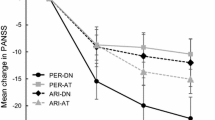Abstract
Olanzapine is a potential new “atypical” antipsychotic agent. This double-blind, acute phase study compared two doses of olanzapine [1 mg/day (Olz1.0); 10 mg/day (Olz10.0)] with placebo in the treatment of 152 patients who met the DSM-III-R criteria for schizophrenia and had a Brief Psychiatric Rating Scale (BPRS)-total score (items scored 0–6) ≥24. In overall symptomatology improvement [BPRS-total score and Positive and Negative Syndrome Scale (PANSS)-total score], Olz10.0 was statistically significantly superior to placebo. In positive symptom improvement (PANSS-positive score, BPRS-positive score), Olz10.0 was statistically significantly superior to placebo. In negative symptom improvement (PANSS-negative score), Olz10.0 was statistically superior to placebo. Olz 1.0 was clinically comparable to placebo in all efficacy comparisons. The only adverse event to show an overall statistically significant incidence difference was anorexia (reported for 10% of placebo-treated and 0% of Olz10.0-treated patients). The Olz10.0-treated patients improved over baseline with respect to parkinsonian and akathisia symptoms, and these changes were comparable with those observed with placebo. There were no dystonias associated with Olz10.0 treatment. At endpoint, the incidence of patients with elevated prolactin values did not differ statistically significantly between placebo-treated and Olz10.0-treated patients. Olanzapine appears to be not only safe and effective, but a promising atypical antipsychotic candidate.
Similar content being viewed by others
References
American Psychiatric Association Task Force on Nomenclature and Statistics (1987) Diagnostic and statistical manual of mental disorders, 3rd edn, revised. APA Press, Washington, DC
Barnes TR (1989) A rating scale for drug-induced akathisia. Br J Psychiatry 154:672–676
Beasley CM, Tollefson G, Tran P, Satterlee W, Sanger T, Hamilton S, Olanzapine HGAD Study Group (1995) Olanzapine versus placebo and haloperidol: acute phase results of the North American double-blind olanzapine trial. Neuropsychopharmacology (in press)
Bymaster FP, Calligaro DO, Falcone JF, Marsh RD, Moore NA, Tye NC, Seeman P, Wong DT (1995) Radioreceptor binding profile of the atypical olanzapine. Neuropsychopharmacology (in press)
Casey DE (1989) Clozapine: neuroleptic-induced EPS and tardive dyskinesia. Psychopharmacology 99:S47-S53
Fuller RW, Snoddy HD (1992) Neuroendocrine evidence for antagonism of serotonin and dopamine receptors by olanzapine (LY170053), an antipsychotic drug candidate. Res Commun Chem Pathol Pharmacol 77:87–93
Guy W (1976) ECDEU assessment manual for psychopharmacology, revised version. US Department of Health, Education and Welfare, Bethesda, Maryland
Hemrick-Luecke SK, Bymaster FP, Falcone JF, Moore NA, Tye NC, Fuller RW (1993) Effect of olanzapine on rat brain receptor binding, acetylcholine levels and monoamine turnover. Tenth Annual Society for Neuroscience Meeting, Indianapolis Chapter, Indianapolis, Ind. Twenty-third Annual Society for Neuroscience Meeting, Washington, DC, 21 May, 7–12 November
Kay SR, Opler LA, Fiszbein A (1986) Positive and negative syndrome scale (PANSS) manual. Multi-Health Systems, North Tonawanda, New York
Meltzer HY (1992) The mechanism of action of clozapine in relation to its clinical advantages. In: Meltzer HY (ed) Novel antipsychotic drugs. Raven Press, New York, pp 1–13
Montgomery S, Beasley CM, Tye NC (1992) Olanzapine: an open label study in schizophrenia. Second International Conference on Schizophrenia, Vancouver, BC, 19–22 July
Moore NA, Tye NC, Axton MS, Risius FC (1992) The behavioral pharmacology of olanzapine, a novel “atypical” antipsychotic agent. J Pharmacol Exp Ther 262:545–551
Moore NA, Calligaro DO, Wong TD, Bymaster F, Tye NC (1993) The pharmacology of olanzapine and other new antipsychotic agents. Curr Opin Invest Drugs 2:281–293
Moore NA, Rees G, Sanger G, Tye NC (1994) Effects of olanzapine and other antipsychotic agents on responding maintained by a conflict schedule. Behav Pharmacol 5:196–202
Rasmussen K, Stockton ME (1993) Olanzapine, a novel atypical antipsychotic, has electrophysiological effects on A9 and A10 dopamine neurons similar to clozapine. American College of Neuropsychopharmacology, Honolulu, Hawaii, 12–17 December
SAS Institute (1990) SAS/STAT user's guide, vol 1&2, 4th edn, 6th version. SAS Institute, Cary, New York
Seeman P, Van Tol HHM (1993) Dopamine receptor pharmacology. Curr Opin Neurol Neurosurg 6:602–608
Simpson GM, Angus JW (1970) A rating scale for extrapyramidal side effects. Acta Psychiatr Scand Suppl 212:11–19
Stockton ME, Rasmussen K (1993) A comparison of olanzapine and clozapine effects on dopamine neuronal activity: an electrophysiological study. Twenty-Third Annual Meeting of the Society for Neuroscience, Washington, DC, 7–12 November
Stockton ME, Rasmussen K (1995) Electrophysiological effects of olanzapine, a novel atypical antipsychotic, an A9 and A10 dopamine neurons. Neuropsychopharmacology (in press)
Tye NC, Moore NA, Rees G, Sanger G, Calligaro DO, Beasley CM (1992) Preclinical pharmacology of olanzapine: a novel “atypical” antipsychotic agent. Second International Conference on Schizophrenia, Vancouver, BC, 18–22 July
Wong DT, Moore NA, Calligaro O, Bymaster FP, Seeman P (1993) The preclinical pharmacology of olanzapine, a novel antipsychotic. Ninth World Congress of Psychiatry, Rio de Janeiro, Brazil, 6–12 June
Author information
Authors and Affiliations
Additional information
This study was funded by Eli Lilly and Company The HGAP Study Group: Alan Green, Massachusetts Mental Health Center, Boston, Mass.; Sharon Dott, Department of Psychiatry, U.T.M.B., Galveston, Texas; Greg Pfister and Luisito Roxas, Psychiatry Clinic, St Alexius Medical Center, Bismarck, North Dakota; Joyce Small, Department of Psychiatry, Indiana University School of Medicine, Indianapolis, Ind.; Marshall Thomas, Colorado Psychiatric Hospital, Denver, Co.; Donna Ames, VA Medical Center, West Los Angeles, Brentwood Division, Los Angeles, Calif.; Nina Schooler and Robert Baker, Special Studies Division, Mayview State Hospital, Bridgeville, Pa.; Robert Levine, New York, N.Y.; Louis Fabre, Fabre Research Clinic, Inc., Houston, Texas; Robert Friedel, University of Alabama Birmingham Clinical Research, Birmingham, Alabama; Allen Safferman and Jeffrey Lieberman, Hillside Hospital, A Division of Long Island Jewish Medical Center, Glen Oaks, N.Y.; Stephen Stahl, Institute for Psychopharmacology Research, San Diego, Calif.
Rights and permissions
About this article
Cite this article
Beasley, C.M., Sanger, T., Satterlee, W. et al. Olanzapine versus placebo: results of a double-blind, fixed-dose olanzapine trial. Psychopharmacology 124, 159–167 (1996). https://doi.org/10.1007/BF02245617
Received:
Revised:
Issue Date:
DOI: https://doi.org/10.1007/BF02245617



